Mississippi is a state with a varied landscape, which means there is also a variety of wildlife. Snakes are found across the entire state, and they are an important part of the ecosystem in every area. Snakes are great for pest control and are routinely misunderstood because of their appearance. However, maintaining healthy snake populations is important to maintaining the health of the overall ecosystem in Mississippi.

The 10 Snakes Found in Mississippi
1. Copperhead Snake
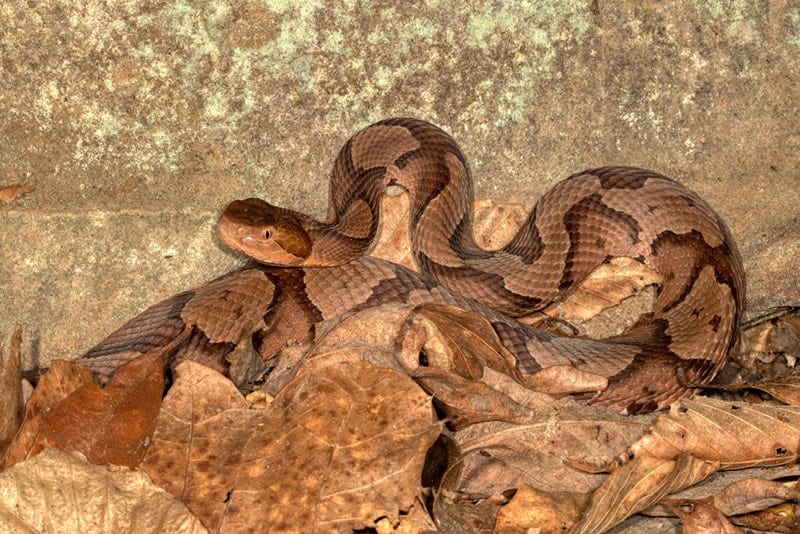
| Species: | A. contortrix |
| Longevity: | 18 years |
| Good to own as a pet?: | No |
| Legal to own?: | With a permit |
| Adult size: | 2 – 3 feet |
| Diet: | Carnivorous |
As one of the most common venomous snakes in Mississippi, the Copperhead is a highly misunderstood snake that accounts for a large number of venomous snake bites every year. They are shy and avoid people, but their excellent camouflage means that people often encounter them without realizing it until it’s too late. A Copperhead bite can cause heart palpitations and arrhythmias, difficulty breathing, and a significant amount of pain. The site of the bite is prone to becoming extremely red, swollen, and painful. These bites are rarely deadly in healthy adults but can be deadly in children and pets.
2. Cottonmouth Snake
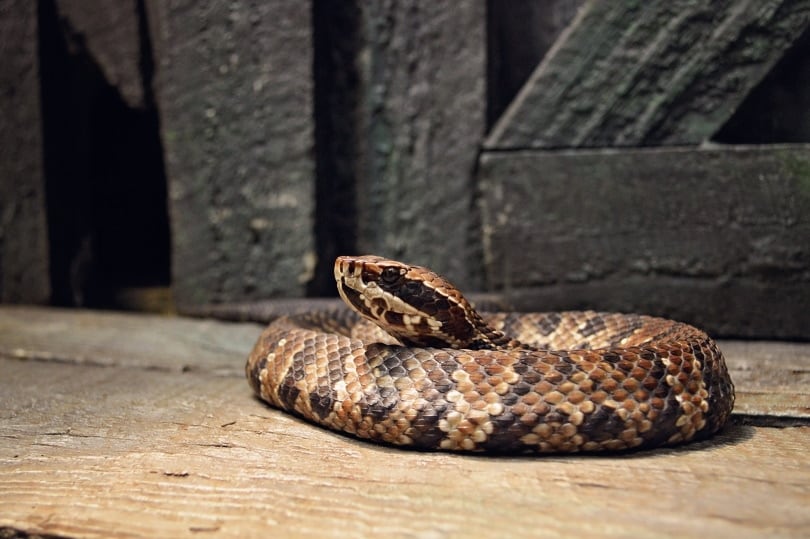
| Species: | A. piscivorus |
| Longevity: | 10 – 20 years |
| Good to own as a pet?: | No |
| Legal to own?: | With a permit |
| Adult size: | 2 – 4 feet |
| Diet: | Carnivorous |
Cottonmouths are both a venomous snake and a water snake in Mississippi, also known colloquially as Water Moccasins. They have a more dangerous venom than their cousin, the Copperhead, but their bites are also not usually deadly in healthy adults. These strong swimmers are usually encountered by people on land since they will usually avoid people making noise in the water. They live off of aquatic and semi-aquatic animals, like fish and amphibians, making them a great source of population control.
3. Pygmy Rattlesnake
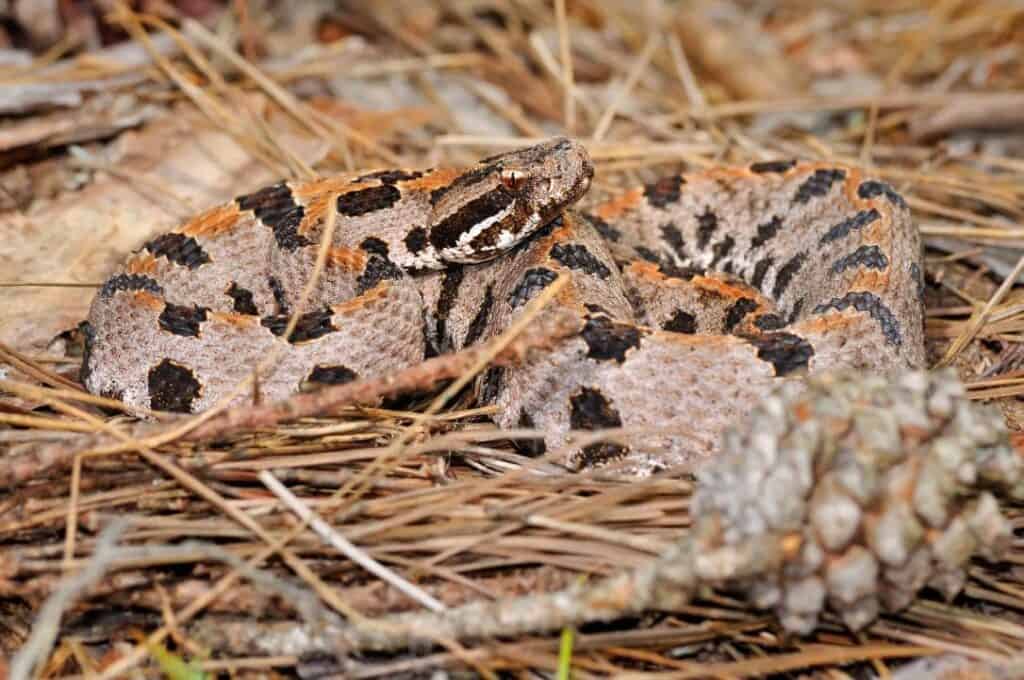
| Species: | S. miliarius |
| Longevity: | 20 years |
| Good to own as a pet?: | Yes |
| Legal to own?: | With a permit |
| Adult size: | 12 – 24 inches |
| Diet: | S. miliarius |
These venomous snakes are one of the smallest Rattlesnake species, giving them their name. The Pygmy Rattlesnake is often considered to be a good pet for people who understand their needs and how to handle them. In the wild, they avoid humans as much as possible. They have tiny rattles that may disappear entirely after a molt, but they usually come back after a few molts. Their bite is not fatal to humans, although it should be immediately assessed by a physician if a bite occurs.
4. Eastern Diamondback Rattlesnake
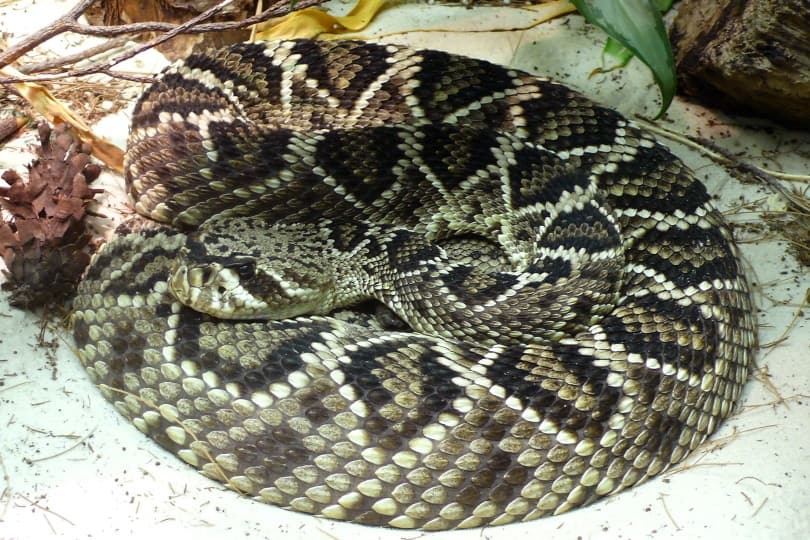
| Species: | C. adamanteus |
| Longevity: | 15 – 20 years |
| Good to own as a pet?: | No |
| Legal to own?: | With a permit |
| Adult size: | 4 – 7 feet |
| Diet: | Carnivorous |
The Eastern Diamondback Rattlesnake is the largest Rattlesnake species in the United States and is one of the heaviest venomous snakes in North and South America. Although this species is listed as a species of least concern, they are believed to have been extirpated from the state of Louisiana and are considered endangered in North Carolina, although no Eastern Diamondback Rattlesnakes have been spotted in the state for approximately 30 years. They usually live in abandoned gopher or tortoise burrows but do make appearances during the warmer parts of the day to bask. They are not good at climbing and are almost always encountered on the ground.
5. Canebrake Rattlesnake
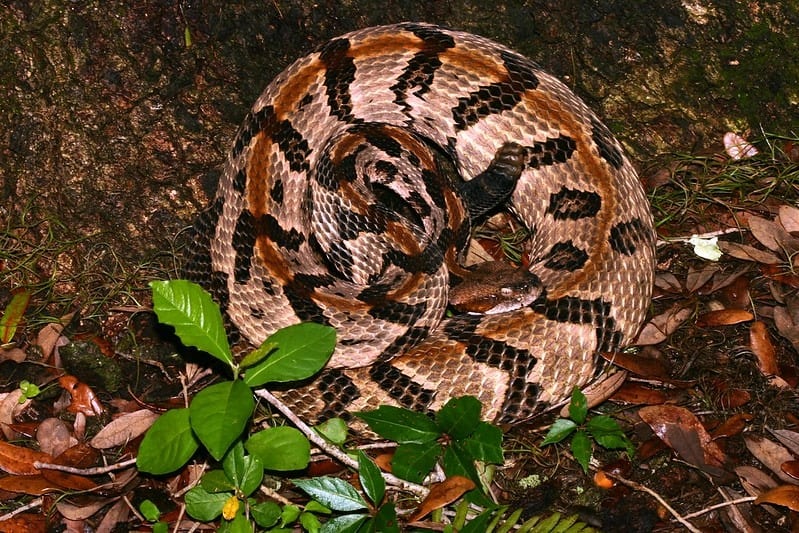
| Species: | C. horridus |
| Longevity: | 10 – 30 years |
| Good to own as a pet?: | No |
| Legal to own?: | With a permit |
| Adult size: | 2.5 – 6 feet |
| Diet: | Carnivorous |
Also known as the Timber Rattlesnake, the Canebrake Rattlesnake is a large, thick-bodied, venomous snake. They are considered a species of least concern, but their populations are in a steady decline, and they are a protected species in many northern states. They are usually found in caves, dens, and hollow tree stumps, especially during the colder months. They are relatively laid-back for Rattlesnakes and will typically watch people carefully without attempting to bite. However, they will bite and deliver deadly venom if threatened.
6. Eastern Milk Snake

| Species: | L. triangulum |
| Longevity: | 15 – 20 years |
| Good to own as a pet?: | Yes |
| Legal to own?: | Yes |
| Adult size: | 2 – 3 feet |
| Diet: | Carnivorous |
This non-venomous species of Kingsnake is similar in appearance to the Coral snake and features red, yellow, and black bands on its body. The mnemonic “red on yellow, kill a fellow; red on black, friend of Jack” is associated with these snakes, since they typically have a banding pattern that only allows black and red bands to touch each other. However, many herpetologists now claim that this mnemonic may lead to dangerous snake bites because it isn’t completely reliable.
7. Eastern Coral Snake

| Species: | M. fulvius |
| Longevity: | 7+ years |
| Good to own as a pet?: | No |
| Legal to own?: | With a permit |
| Adult size: | 2 – 3 feet |
| Diet: | Carnivorous |
As the other half of the mnemonic mentioned above, Coral snakes often have black, yellow, and red bands, with the red and yellow bands touching each other. However, this isn’t true 100% of the time and the mnemonic shouldn’t be considered gospel, although this is almost always true in North American Coral snakes. They have one of the most potent venoms of any snake in the US, but bites from these snakes are uncommon because they are reclusive snakes that spend most of their time hiding away from humans. In fact, there are only 15 – 30 bites from Coral snakes annually in the US.
8. Common Garter Snake
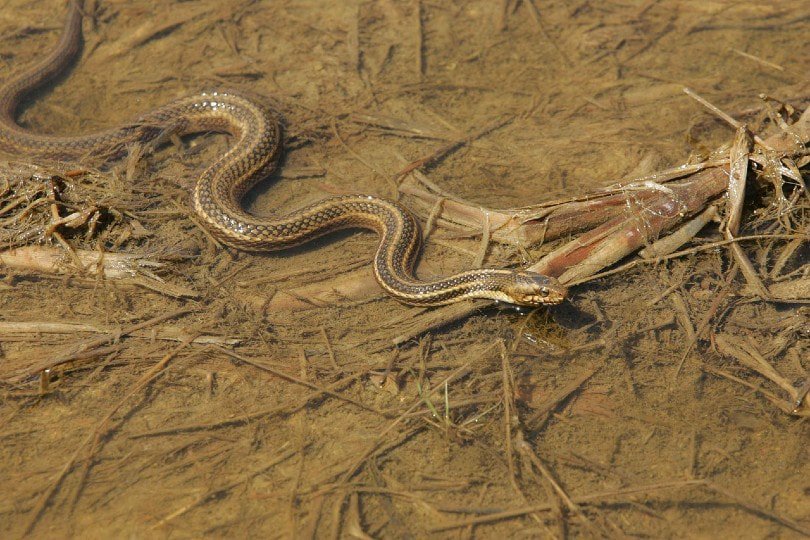
| Species: | T. sirtalis |
| Longevity: | 4 – 10 years |
| Good to own as a pet?: | Yes |
| Legal to own?: | Yes |
| Adult size: | 18 – 26 inches |
| Diet: | Carnivorous |
These docile, non-venomous snakes are often spotted in people’s yards. They do avoid humans, but some people keep them as pets. Although it is legal to own them as pets, it isn’t legal to take them from their natural environment to do so. They are active during the day, which leads to them being spotted frequently. They can tolerate a broader temperature range than many other snakes can. Although they hibernate during the winter like other snakes, they will come out to bask on mild fall and winter days.
9. Black Racer

| Species: | C. constrictor |
| Longevity: | 10 years |
| Good to own as a pet?: | No |
| Legal to own?: | Yes |
| Adult size: | 1.5 – 5 feet |
| Diet: | Carnivorous |
Also called the North American Racer, Black Racers are long, thin snakes with distinct, prominent eyes. Adults are almost solid black or bluish black with white around the chin, while juveniles are grey with reddish brown markings. They are non-venomous and are prone to rapidly escaping to shelter if approached. If cornered, they will rapidly vibrate the tail to create a rattling sound in leaf litter, making themselves appear to be a Rattlesnake. They will usually only bite if cornered and grabbed. Although some Racers make good pets, the Black Racer usually doesn’t. They aren’t fond of being handled by humans and don’t thrive in small environments.
10. Scarlet Kingsnake

| Species: | L. elapsoides |
| Longevity: | 20 – 30 years |
| Good to own as a pet?: | No |
| Legal to own?: | Yes |
| Adult size: | 1 – 1.5 feet |
| Diet: | Carnivorous |
The Scarlet Kingsnake is also known as the Scarlet Milk Snake. They are non-venomous snakes that are great for pest control, and they will even eat other snakes, including venomous snakes. They are another example of the red, black, and yellow bands where the red and black bands touch each other. They are smaller than the Milk snake and are not usually seen out in the open, preferring instead to live underground and under objects, like fallen logs and rocks. They are nocturnal and extremely shy, making them poor pets.

Conclusion
Snakes are a necessary part of the ecosystem, regardless of whether you like them or not. They are fascinating, diverse creatures that work to create a healthier environment for all of us. Giving snakes their space and respecting them helps prevent bites and incidents that may lead to harm or death of the snake. If you cross paths with a snake in Mississippi, it’s best to let it continue on its way unbothered, even if it’s not a venomous snake.
Related articles:
Featured Image Credit: Chase D’animulls, Shutterstock
